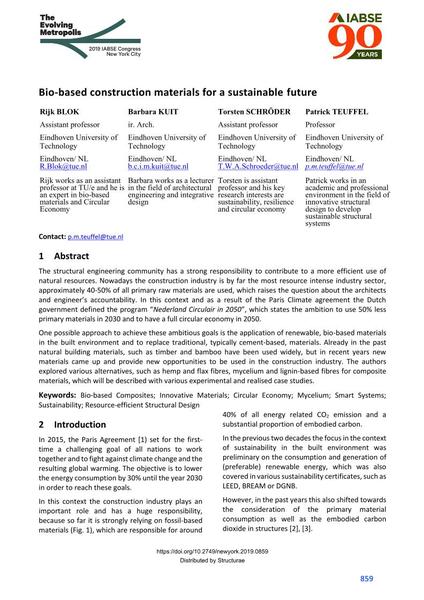Bio-based construction materials for a sustainable future

|
|
|||||||||||
Détails bibliographiques
| Auteur(s): |
Rijk Block
(Eindhoven University of Technology)
Barbara Kuit (Eindhoven University of Technology) Torsten Schröder (Eindhoven University of Technology) Patrick Teuffel (Eindhoven University of Technology) |
||||
|---|---|---|---|---|---|
| Médium: | papier de conférence | ||||
| Langue(s): | anglais | ||||
| Conférence: | IABSE Congress: The Evolving Metropolis, New York, NY, USA, 4-6 September 2019 | ||||
| Publié dans: | The Evolving Metropolis | ||||
|
|||||
| Page(s): | 859-865 | ||||
| Nombre total de pages (du PDF): | 7 | ||||
| DOI: | 10.2749/newyork.2019.0859 | ||||
| Abstrait: |
The structural engineering community has a strong responsibility to contribute to a more efficient use of natural resources. Nowadays the construction industry is by far the most resource intense industry sector, approximately 40-50% of all primary raw materials are used, which raises the question about the architects and engineer’s accountability. In this context and as a result of the Paris Climate agreement the Dutch government defined the program “Nederland Circulair in 2050”, which states the ambition to use 50% less primary materials in 2030 and to have a full circular economy in 2050. One possible approach to achieve these ambitious goals is the application of renewable, bio-based materials in the built environment and to replace traditional, typically cement-based, materials. Already in the past natural building materials, such as timber and bamboo have been used widely, but in recent years new materials came up and provide new opportunities to be used in the construction industry. The authors explored various alternatives, such as hemp and flax fibres, mycelium and lignin-based fibres for composite materials, which will be described with various experimental and realised case studies. |
||||
| Mots-clé: |
durabilité
|
||||
